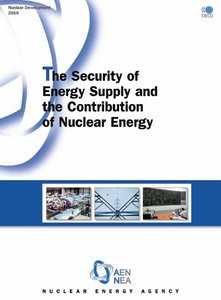The Security of Energy Supply and the Contribution of Nuclear Energy
Posted by Hamada Rageh on Sunday, January 9, 2011
The Security of Energy Supply and the Contribution of Nuclear Energy
Nuclear Energy Agency
OECD / NEA | 13 Dec 2010 | ISBN: 9264096356 | 171 pages | PDF | 5 MB

What contribution can nuclear energy make to improve the security of
energy supply? This study, which examines a selection of OECD member
countries, qualitatively and quantitatively validates the often
intuitive assumption that, as a largely domestic source of electricity
with stable costs and no greenhouse gas emissions during production,
nuclear energy can make a positive contribution.
Table of Contents
FOREWORD
EXECUTIVE SUMMARY
1. THE SECURITY OF ENERGY SUPPLY AND THE CONTRIBUTION OF NUCLEAR
ENERGY – CONCEPTS AND ISSUES
1.1 Energy supply security: An introduction
1.2 Why security of energy supply remains a policy issue in OECD countries
1.3 The external dimension: import dependence, resource exhaustion and carbon policy
1.4 The internal dimension: economic, financial and technical conditions for energy supply security
1.5 Orientations for government policies to enhance the security of energy supply
1.6 Conclusions
2. INDICATORS AND MODELS FOR MEASURING SECURITY OF ENERGY
SUPPLY RISKS
2.1 Introduction
2.2 Different approaches towards designing the Supply/Demand Index
2.3 A detailed review of selected security of supply indicators
2.4 Comprehensive models for assessing the security of energy supply
2.5 The Supply/Demand Index
2.6 Concluding observations
3. EVOLUTION OF THE SECURITY OF ENERGY SUPPLY IN OECD COUNTRIES
3.1 Time-dependent quantification of the security of energy supply
3.2 Changes in security of supply in selected OECD countries
3.3 Electricity generation and the security of energy supply
3.4 The contribution of nuclear energy and energy intensity to the security of energy supply
3.5 The geographical distribution of SSDI values
3.6 Conclusions
4. PUBLIC ATTITUDES TOWARDS NUCLEAR ENERGY AND SECURITY OF ENERGY SUPPLY
4.1 Public interest in energy supply security and related issues in the European Union
4.2 What kind of indicators do consumers use to evaluate their security of energy supply?
4.3 Awareness of the importance of security of supply and public support for nuclear energy
4.4 Conclusions
5. CONCLUSIONS
ANNEXES
1. List of Experts
2. Acronyms
Following an analysis of the meaning and context of
security of supply, the study uses transparent and policy-relevant
indicators to show that, together with improvements in energy
efficiency, nuclear energy has indeed contributed significantly to
enhanced energy supply security in OECD countries over the past 40
years.
Table of Contents
FOREWORD
EXECUTIVE SUMMARY
1. THE SECURITY OF ENERGY SUPPLY AND THE CONTRIBUTION OF NUCLEAR
ENERGY – CONCEPTS AND ISSUES
1.1 Energy supply security: An introduction
1.2 Why security of energy supply remains a policy issue in OECD countries
1.3 The external dimension: import dependence, resource exhaustion and carbon policy
1.4 The internal dimension: economic, financial and technical conditions for energy supply security
1.5 Orientations for government policies to enhance the security of energy supply
1.6 Conclusions
2. INDICATORS AND MODELS FOR MEASURING SECURITY OF ENERGY
SUPPLY RISKS
2.1 Introduction
2.2 Different approaches towards designing the Supply/Demand Index
2.3 A detailed review of selected security of supply indicators
2.4 Comprehensive models for assessing the security of energy supply
2.5 The Supply/Demand Index
2.6 Concluding observations
3. EVOLUTION OF THE SECURITY OF ENERGY SUPPLY IN OECD COUNTRIES
3.1 Time-dependent quantification of the security of energy supply
3.2 Changes in security of supply in selected OECD countries
3.3 Electricity generation and the security of energy supply
3.4 The contribution of nuclear energy and energy intensity to the security of energy supply
3.5 The geographical distribution of SSDI values
3.6 Conclusions
4. PUBLIC ATTITUDES TOWARDS NUCLEAR ENERGY AND SECURITY OF ENERGY SUPPLY
4.1 Public interest in energy supply security and related issues in the European Union
4.2 What kind of indicators do consumers use to evaluate their security of energy supply?
4.3 Awareness of the importance of security of supply and public support for nuclear energy
4.4 Conclusions
5. CONCLUSIONS
ANNEXES
1. List of Experts
2. Acronyms